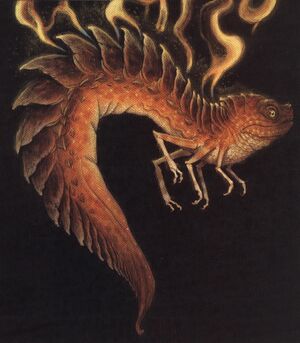| Fire Salamander | |||
|---|---|---|---|

| |||
| General information | |||
| Universe | The Spiderwick Chronicles | ||
| Aliases | Salamander | ||
| Classification | Salamander flammulaticus | ||
| Species type | Salamander | ||
| Homeworld | Earth | ||
| Intelligence | Non-sapient | ||
| Biochemistry | Carbon-based lifeform | ||
| Biological information | |||
| Locomotion | Crawling | ||
| Feeding behavior | Carnivorous | ||
| Lineage information | |||
| Cultural information | |||
| Alignment | Neutral | ||
| Sociocultral characteristics | |||
| Scientific taxonomy | |||
| Planet | Earth | ||
| Domain | Eukaryota | ||
| Kingdom | Animalia | ||
| Subkingdom | Eumetazoa | ||
| Infrakingdom | Bilateria | ||
| Superphylum | Deuterostomia | ||
| Phylum | Chordata | ||
| Subphylum | Vertebrata | ||
| Infraphylum | Gnathostomata | ||
| Superclass | Tetrapoda | ||
| Class | Amphibia | ||
| Subclass | Lissamphibia | ||
| Superorder | Batrachia | ||
| Order | Caudata | ||
| Suborder | Arthroserpentes (Somarinoa, 2014) | ||
| Family | Spinostegos (Somarinoa, 2014) | ||
| Genus | Salamander | ||
| Species | flammulaticus | ||
| Other information | |||
| Status | Data Deficient | ||
| Creator | Holly Black | ||
Fire Salamanders are a tiny and deceptively agreeable creature that barely resembles its namesake, the salamanders, having more akin to an eel or serpent than these creatures. Surprisingly, they also possess six insect-like legs, a unique feature amongst mythical salamanders. No close relative species is currently known. As with most mythical salamanders, the Fire Salamander is able to withstand extreme levels of heat, making it a thermophile. In fact, it has developed glands that allow it to ignite when threatened as a defensive measure, creating a white-hot flame surrounding its body. Despite this flame, their body is seemingly flame retardant as its skin will remain cool to the touch no matter the surrounding temperature.
As they raise their dorsal plates, small glands underneath release a gas which ignites when it comes in contact with the surrounding air. Also, their excrement will burst into flames if struck, stepped on, or hurled! If a match were to so much as touch the back of a Salamander, it will light.
They can usually be found in damp locations or woodpiles, which can cause problems for regular folks bringing bundles of firewood into their home if the wood is left unchecked beforehand. In these cases they will appear to be "swimming among the white-hot flames until it vanishes up the chimney". Fire Salamanders have also been seen near volcanoes.
Fire Salamanders are a highly-sought after commodity amongst both alchemists, who use them as an integral component in transforming lead into gold, and hunters, who seek their hides to construct flame-retardant gloves. While swift and believed to secrete a poison so terrible that it will burn whatever it touches, their position is given away by an odor of sulfur and a resourceful individual may catch one using tongs. A safe way to contain a Salamander is to place it in an iron box.
Recipe for turning lead into gold[]
Melt together pure mercury and gold in the intense heat of a salamander.
The substance will first blacken, then it will turn white, then it will yield a fine powder, which when commingled with lead, will change into gold.